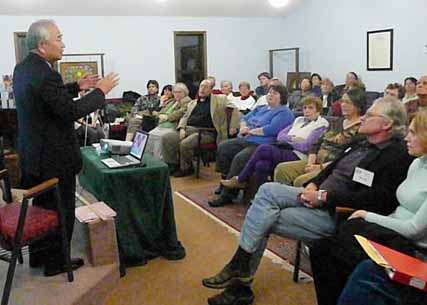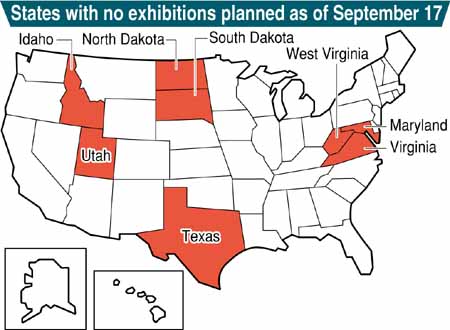A-bomb exhibitions in U.S. wrap up their first year
Sep. 26, 2008
by Hiromi Morita, Staff Writer
It has been one year since a nationwide series of A-bomb exhibitions in the United States was initiated. So far, the exhibitions have been held in 70 cities in the United States, giving American citizens an opportunity to comprehend the true effects of the nuclear bombing of Japan. The exhibitions also have produced some results, including new efforts in the U.S. to abolish nuclear weapons.
The first exhibition opened in Rochester, New York. The events have been held in 70 cities, including cities in 34 states plus Washington, D.C. Among these, 41 cities in 23 states were visited by a total of 13 A-bomb survivors serving as volunteer speakers, including some survivors living in the U.S.
According to a staff member of the Outreach Division at Hiroshima Peace Memorial Museum, by the end of this March nearly 10,000 Americans had visited the exhibitions, among whom 6,132 had listened to A-bomb survivors' experiences.
"Though the number of visitors is very small compared with the total population of the U.S., this is very significant," remarked Yukio Yoshioka, 79. Mr. Yoshioka, the secretary general of Hiroshima Prefectural Confederation of A-bomb Sufferers Organizations, participated in the Colorado program. In the U.S., a great many people firmly believe that the A-bomb hastened the end of the war, and their awareness of the full consequences of the bombing was found to be less than the presenters had imagined. "Many U.S. citizens were surprised to learn that A-bomb survivors are still suffering from diseases caused by radiation from the nuclear blasts. So, it is vital that people from our A-bombed city try to raise others’ awareness of the total effects of the bombing," Mr. Yoshioka added.
The idea of the exhibitions came from Steven Leeper, 60, the American chairman of the Hiroshima Peace Culture Foundation, which administers Hiroshima Peace Memorial Museum and other facilities. Mr. Leeper set a goal of holding exhibitions in Washington, D.C. and in two cities in each of the 50 states by the end of this year, which is a presidential election year in the United States.
Mr. Leeper has traveled to most of the exhibitions and reports that the program has achieved better results than expected. He has received much feedback from the U.S., and the exhibitions have been reported by local newspapers and television stations in many cities. Photo panels displayed at some of the exhibitions are being reused in several ways. For example, panels are being displayed in local schools and churches.
Citizens in some cities where the exhibitions were held have urged their mayors to join Mayors for Peace. In Wisconsin, it is reported that citizens called on the state legislature to consider a resolution supporting the elimination of nuclear weapons.
Japanese support for the exhibitions has been increasing. Donations were solicited by the Hiroshima Peace Culture Foundation to defray the cost of running an opinion ad calling for the abolition of nuclear weapons in local newspapers prior to the exhibitions. The response has topped 9 million yen, far exceeding the target figure of 6 million yen.
There are, however, some problems to be solved. In eight states, including Utah, Virginia and Texas, exhibitions have not been scheduled yet. In some cases local supporters for the exhibitions have not been found, while in other cases sending A-bomb survivors to the cities is difficult.
Hiroshima City initially planned to send A-bomb survivors to 25 cities. Thanks to the cooperation of Hiroshima Prefectural Confederation of A-bomb Sufferers Organizations and A-bomb survivors living in the U.S., the city has been able to send A-bomb survivors to 41 cities. However, responding to all requests for A-bomb survivors in the future may be difficult due to the survivors’ old age, budget limitations and other factors.
Hiroshima city is planning to introduce a TV conferencing system to transmit messages from A-bomb survivors in Japan to the U.S. "As early as possible, we need to consider new measures to convey the true extent of the A-bomb damage, rather than relying only on A-bomb survivors to continue our efforts," remarked Akira Tanigawa, Deputy Director at Hiroshima Peace Memorial Museum.
(Originally published on September 18, 2008)
Related articles
A-bomb survivor Itsuki Munakata to play taiko drum for peace in the U.S. (July 23, 2008)
A-bomb testimony fosters reconciliation (Feb. 1, 2008)
Announcements for Atomic Bomb Exhibitions to appear in U.S. newspapers nationwide (Jan. 11, 2008)
It has been one year since a nationwide series of A-bomb exhibitions in the United States was initiated. So far, the exhibitions have been held in 70 cities in the United States, giving American citizens an opportunity to comprehend the true effects of the nuclear bombing of Japan. The exhibitions also have produced some results, including new efforts in the U.S. to abolish nuclear weapons.
The first exhibition opened in Rochester, New York. The events have been held in 70 cities, including cities in 34 states plus Washington, D.C. Among these, 41 cities in 23 states were visited by a total of 13 A-bomb survivors serving as volunteer speakers, including some survivors living in the U.S.
According to a staff member of the Outreach Division at Hiroshima Peace Memorial Museum, by the end of this March nearly 10,000 Americans had visited the exhibitions, among whom 6,132 had listened to A-bomb survivors' experiences.
"Though the number of visitors is very small compared with the total population of the U.S., this is very significant," remarked Yukio Yoshioka, 79. Mr. Yoshioka, the secretary general of Hiroshima Prefectural Confederation of A-bomb Sufferers Organizations, participated in the Colorado program. In the U.S., a great many people firmly believe that the A-bomb hastened the end of the war, and their awareness of the full consequences of the bombing was found to be less than the presenters had imagined. "Many U.S. citizens were surprised to learn that A-bomb survivors are still suffering from diseases caused by radiation from the nuclear blasts. So, it is vital that people from our A-bombed city try to raise others’ awareness of the total effects of the bombing," Mr. Yoshioka added.
The idea of the exhibitions came from Steven Leeper, 60, the American chairman of the Hiroshima Peace Culture Foundation, which administers Hiroshima Peace Memorial Museum and other facilities. Mr. Leeper set a goal of holding exhibitions in Washington, D.C. and in two cities in each of the 50 states by the end of this year, which is a presidential election year in the United States.
Mr. Leeper has traveled to most of the exhibitions and reports that the program has achieved better results than expected. He has received much feedback from the U.S., and the exhibitions have been reported by local newspapers and television stations in many cities. Photo panels displayed at some of the exhibitions are being reused in several ways. For example, panels are being displayed in local schools and churches.
Citizens in some cities where the exhibitions were held have urged their mayors to join Mayors for Peace. In Wisconsin, it is reported that citizens called on the state legislature to consider a resolution supporting the elimination of nuclear weapons.
Japanese support for the exhibitions has been increasing. Donations were solicited by the Hiroshima Peace Culture Foundation to defray the cost of running an opinion ad calling for the abolition of nuclear weapons in local newspapers prior to the exhibitions. The response has topped 9 million yen, far exceeding the target figure of 6 million yen.
There are, however, some problems to be solved. In eight states, including Utah, Virginia and Texas, exhibitions have not been scheduled yet. In some cases local supporters for the exhibitions have not been found, while in other cases sending A-bomb survivors to the cities is difficult.
Hiroshima City initially planned to send A-bomb survivors to 25 cities. Thanks to the cooperation of Hiroshima Prefectural Confederation of A-bomb Sufferers Organizations and A-bomb survivors living in the U.S., the city has been able to send A-bomb survivors to 41 cities. However, responding to all requests for A-bomb survivors in the future may be difficult due to the survivors’ old age, budget limitations and other factors.
Hiroshima city is planning to introduce a TV conferencing system to transmit messages from A-bomb survivors in Japan to the U.S. "As early as possible, we need to consider new measures to convey the true extent of the A-bomb damage, rather than relying only on A-bomb survivors to continue our efforts," remarked Akira Tanigawa, Deputy Director at Hiroshima Peace Memorial Museum.
(Originally published on September 18, 2008)
Related articles
A-bomb survivor Itsuki Munakata to play taiko drum for peace in the U.S. (July 23, 2008)
A-bomb testimony fosters reconciliation (Feb. 1, 2008)
Announcements for Atomic Bomb Exhibitions to appear in U.S. newspapers nationwide (Jan. 11, 2008)









